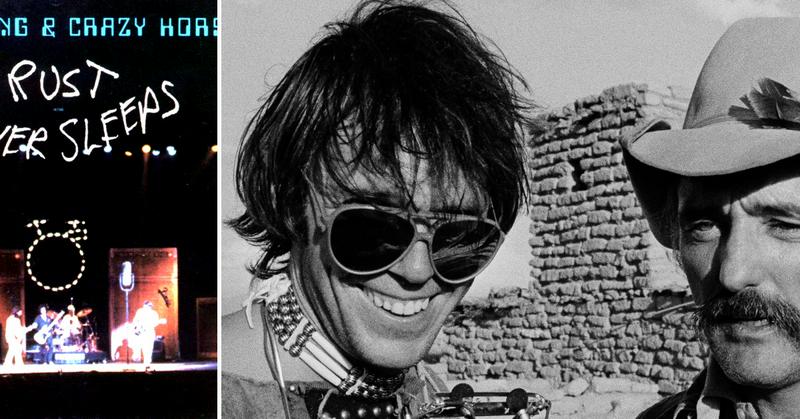Neil Young's 'Rust Never Sleeps:' A '60s Rocker Kicks Ass In '79
By | July 30, 2019

On July 2, 1979, Neil Young and Crazy Horse released Rust Never Sleeps, a meditation on the ephemeral nature and importance of rock and roll. The record came to define the sound of rock for a generation -- and it was recorded by a guy who'd played Woodstock a decade earlier. Blending his folkie past with the exuberant chaos and fuzz of punk, Neil Young blew up his sound and came out on the other side with one of the greatest records of the 20th century.
Recorded during a theatrical tour and taken into a studio where the audience was edited out while tons of overdubs were added, the record thumbed its nose at the concept of a “live” record while showing listeners exactly what Neil Young was capable of.
'Rust Never Sleeps' Was Young's Mantra On Tour

The title “Rust Never Sleeps” is something that Young heard while he was hanging out with none other than the post-punk weirdoes Devo. He first saw the band when they played at the Starwood Club in LA in 1977. The band gave a performance that absolutely floored Young, turning him into a fan for life. Even though he didn’t want to devolve (as Devo preached), Young knew that if he wanted to stay relevant he had to tap the band’s energy and do something new.
While working with the group on the film Human Highway, Young overheard the members of Devo saying the phrase “rust never sleeps,” an old slogan for Rustoleum paint. The phrase stuck with Young, suggesting that complacency is a creeping threat to an aging artist's credibility.
As he put together the tour and the album that followed Young kept the phrase in mind with an intent to shake things up.
DEVO Had A Weird Idea For 'Hey Hey, My My'

Neil Young was lost in the late ‘70s. He never stopped releasing records but at the time he also thought about being a director. It made sense -- if Dennis Hopper could do it, then surely Young could handle making a movie. He decided to make a movie called Human Highway featuring Dean Stockwell, Russ Tamblyn and his new buddies in Devo.
The movie started filming in 1978 (before the recording of Rust Never Sleeps) and one of the centerpieces of the very weird movie is a 10 minute, impromptu performance of “Hey Hey, My My (Into the Black).” According to Mark Mothersbaugh, Young told the band the chord changes and they just jammed it out in front of the cameras.
Young ended up recording a super electric version of "Hey Hey, My My (Into The Black)" to close out Rust Never Sleeps, and while he was open to notes from his friends, Young didn’t take Mark Mothersbaugh’s idea to use the name “Johnny Spud” instead of Johnny Rotten.
Young Was Bored On Tour, So He Decided To Blow Things Up

Human Highway wasn’t anywhere near being finished in 1978 and Young had an album to promote. After all, his job was ostensibly “rock star.” He’d just released the laid back album Comes a Time and had to tour in support, but the mercurial Young was already over it. In an interview with Rolling Stone he told Cameron Crowe about the record:
It was made to come out a year ago and got hung up with pressing problems. I hear it on the radio and it sounds nice... But I’m somewhere else now. I’m into rock & roll.
That dedication to rock and roll gave Young an idea. Rather than just perform an acoustic tour he decided to turn the idea of the concert on its head. He had his roadies bring out massive piles of amplifiers while wearing ponchos covered in giant eyes. Halfway through the set Young switched from his acoustic guitar to something more electric when he was joined by his backing band Crazy Horse.
In between the breaks he played pieces of his old songs over the PA systems along with PSAs about bad LSD. During some of his more laid back songs like “Hurricane” the roadies helped out with sound effects.
Most Of The Album Was Recorded Live And Overdubs Were Added Later

Rust Never Sleeps is sort of a live album, but not really. In order to get the chaotic feel of a live show Young recorded his set at a few different stops on the tour, but specifically at the Cow Palace in San Francisco, complete with the bookends of "My My, Hey Hey (Out of the Blue)" and "Hey Hey, My My (Into the Black).” The live tracks were then taken to the studio and completely revamped.
Young removed all of the audience noise that he could - it was impossible to pull it out of the opening and closing tracks - guitar was added, as well as handclaps and backing vocals. Two tracks, “Pocahontas” and “Sail Away,” which were holdovers from his previous album, were added to the record, further distancing it from a completely live affair.
The Album Reinvigorated Young

No one’s ever complained about Neil Young being a bad artist, but when Rust Never Sleeps was released critics gave him unequivocal praise. This was an album that set him apart from his ex-bandmates and folk rock contemporaries. It showed that he could try something new and succeed without looking like a desperate old rock guy in search of authenticity.
That forward thinking attitude led Young to continue experimenting throughout the ‘80s on albums like re.ac.tor and the electronic album Trans. But it was with Rust Never Sleeps that Young signaled he would rather evolve than stagnate.
